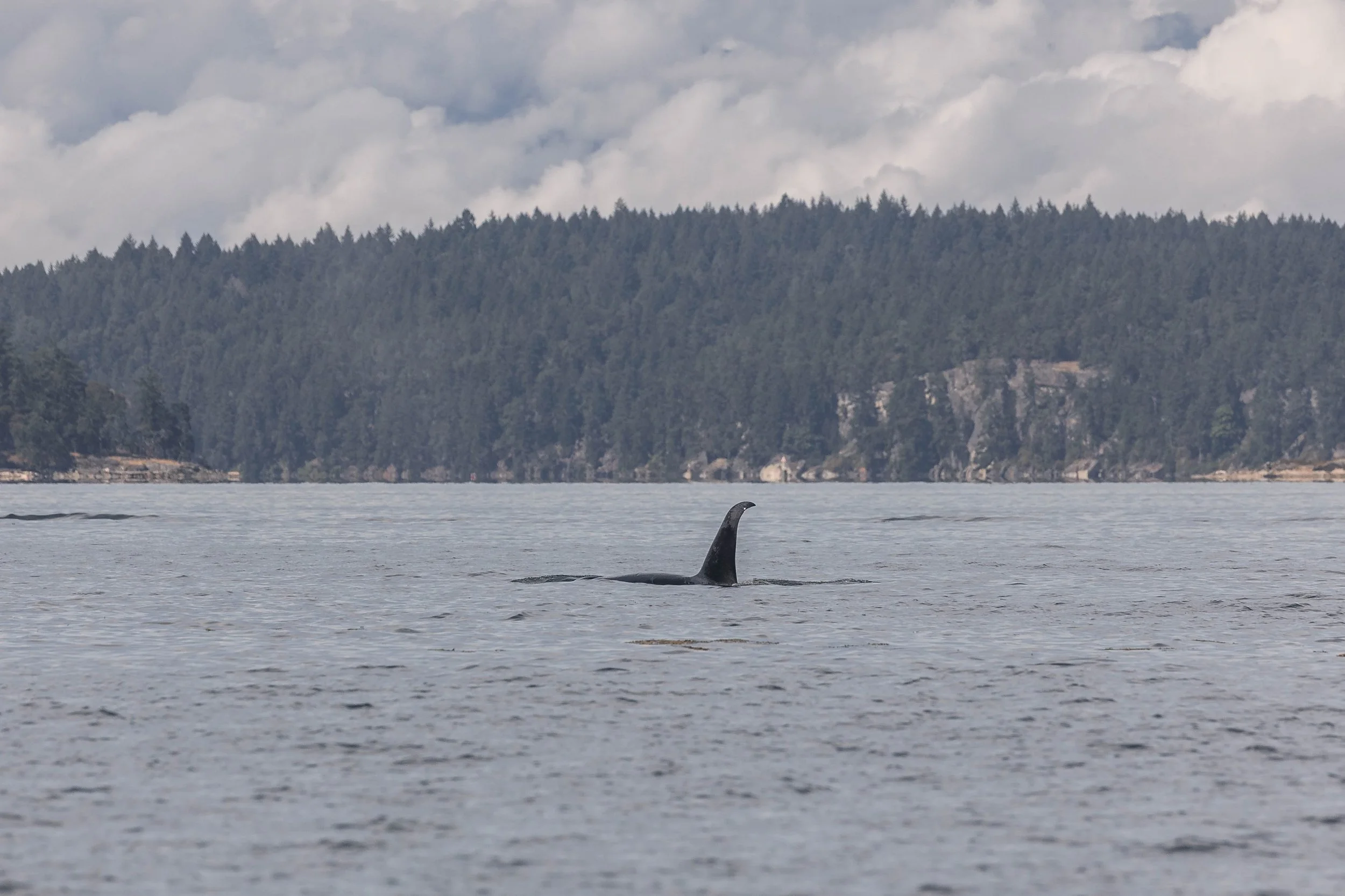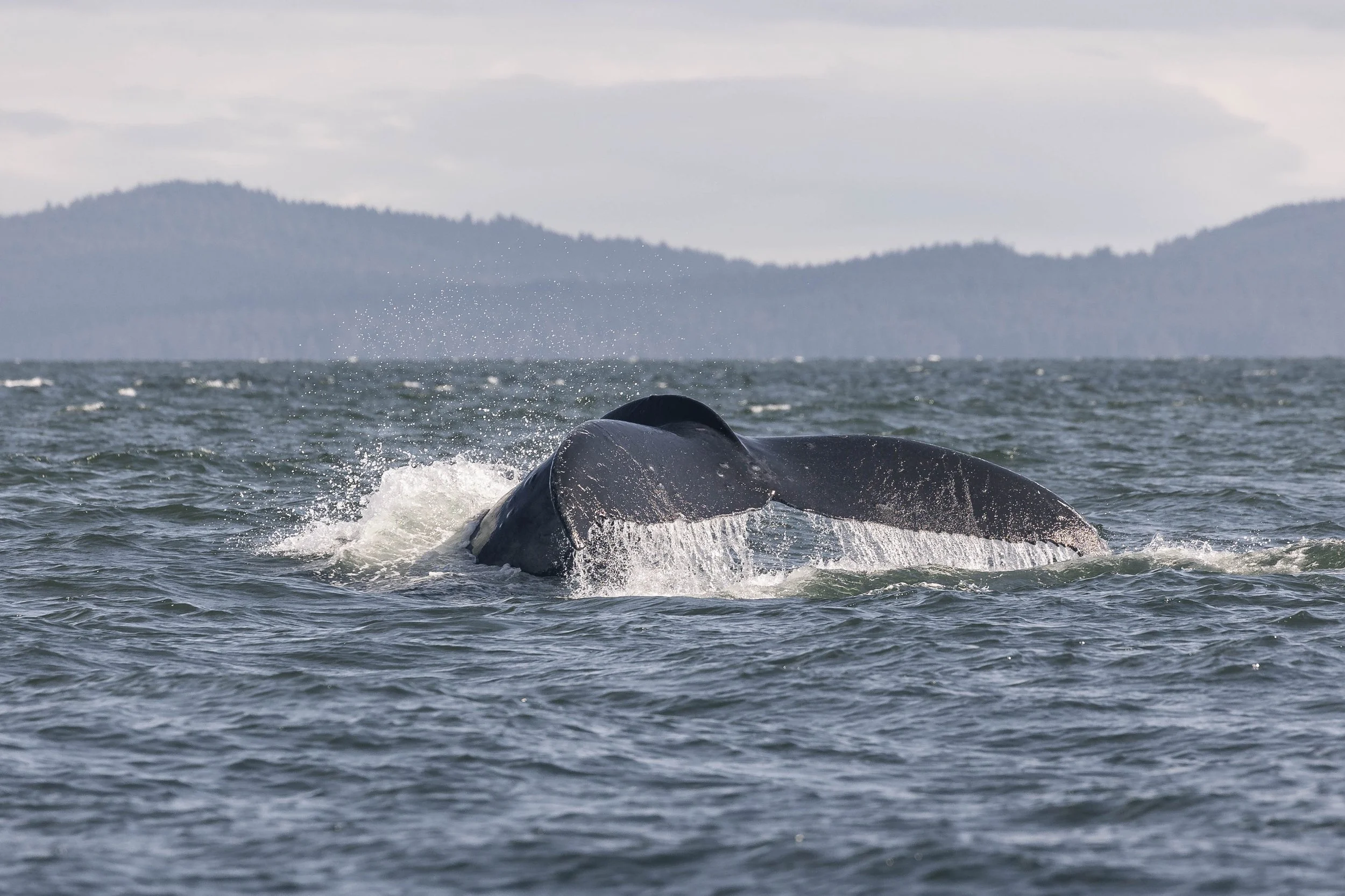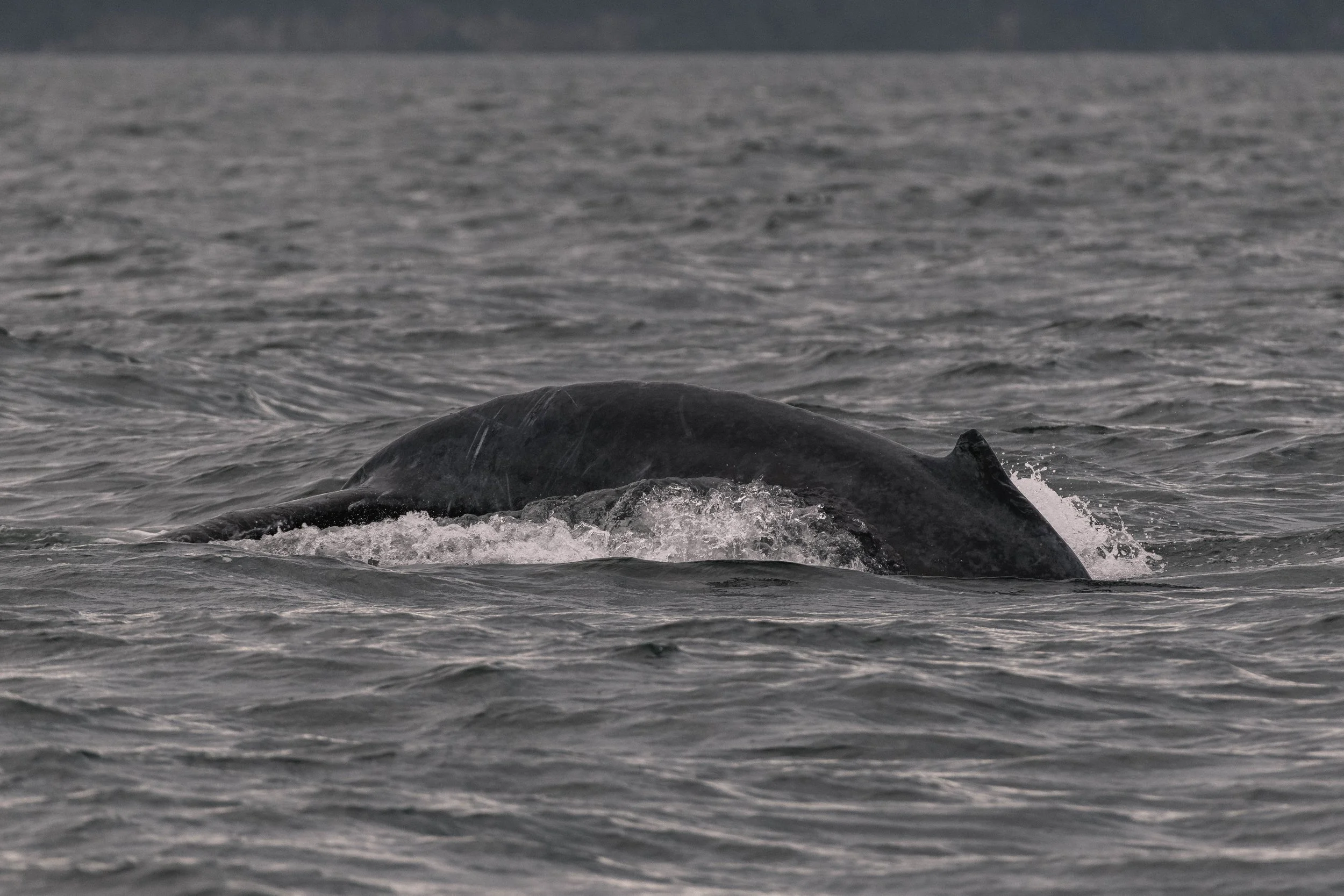July 9, 2025, 3:30 PM - Jude the Orca and Anvil the Humpback
Today’s tour started by venturing south from Nanaimo, crossing Dodd Narrows and entering the protected waters of the Southern Gulf Islands. This place is home to a unique host of wildlife, with the rocky shorelines and protected bays becoming the perfect area to support very high biodiversity. The changing tides bring currents with them when passing between the islands and through the passages we travelled, mixing the water column and increasing the amount of life found here.
The first notable species that we found was a lone male Transient Orca, swimming north through Stuart Channel: T049A2 Jude. Jude, being an apex predator feeding on other marine mammals, has a few reasons that he might be travelling solo. Firstly, hunting other mammals means that his prey is very intelligent, so he has to rely on stealth, sneaking up on his prey undetected, so he can successfully strike. While some ecotypes of orca have different hunting strategies that wouldn’t allow for the success of a lone male (like the very complex and coordinated efforts of the fish-eating orca), seeing a lone individual in the mammal eaters is much more common. Not only does his solitary life help with sneaking up on his prey, but it also helps him develop a sense of independence. Sometimes, when males leave their pods, they will only do so for a few years before returning to travel with them once again, usually once there are fewer individuals present. Noah (T049A1), Judes’ brother, is like this: travelling away from his pod for some time before returning for a while, then repeating the process. Jude isn’t always alone, though, as he will sometimes meet up with others and spend time socializing before going off on his own once again.
Although we didn’t spend too much time with Jude, the short time spent with him really made us understand the importance of the orca in our ecosystem. After Jude, we travelled out of the protection of the Islands, into the Strait of Georgia. Although less contained than the narrow channels amongst the islands, the Strait still contains an astounding amount of biodiversity. The surface waters are home to all sorts of plankton species, which is what draws in some of the larger predators like the humpback whale. Also solitary today, we got to see Anvil (BCZ0410) feeding in these rich waters. Unlike the transient orca, who feed high in the trophic levels, humpbacks feed quite low, on the plankton itself, like Krill, and the small schooling fish that feed on the plankton. Anvil will be using all of the food available here to bulk up for her migration, in this case to Hawaii. While down south, the waters don’t have the same productivity that ours do, so less (if any) food is available to the humpbacks. This means that the fat reserves that are built over the summers here are the main source of energy for the breeding humpback whales. In addition to Anvil, one other yet-to-be-identified humpback whale was spotted by one of our boats, but with only a brief glimpse before dipping back beneath the surface to feed, we didn’t end up with enough photos to figure out who this was.
The next stop gave a sharp contrast to the gentle travel and feeding that we had witnessed from the whales so far today, with Stinky Rock teeming with life. There was a large colony of Sea Lions fighting for position on the remaining rocks left by the rising tide, growling and barking at each other to secure their place. In the water, more sea lions were also causing a ruckus, quickly moving through the waves while playing with each other, but also keeping their keen eyes on us as we floated nearby. The Harbour Seals also like to use this rocky outcrop to haul out, and there were plenty of them watching us from the rocks as well. One pair in particular caught our eye, since there was a very young pup sitting silently by mom’s side. Likely under a week old, this young pup wasn’t straying too far from its mother, although the crashing waves were doing their best to separate them. All of these pinnipeds seen here are important parts of our ecosystem, playing a role as both predator and prey in these waters. Their populations and the populations of the orca, fish, and cephalopods in the area are very tightly interlaced thanks to these predator-prey relationships.
After drinking in the scenery on the way back towards Nanaimo, the tour concluded by observing the nesting cormorants on the sandstone cliffs of Gabriola Island. Although the towering cliffs seem like a precarious place to nest, they provide a lot of protection from most of these birds’ predators. Land-based animals, like raccoons, rats, or other egg-eating animals, wouldn’t be able to make it down the steep rock face to their nests. There are other animals, such as the bald eagles, that wouldn’t be deterred by the heights and might still be able to raid the nests, but there are fewer of them present to pose as big of a risk.
This trip showed us a great variety of wildlife, from the solo travelling whales to the busy colonies of birds and pinnipeds. This variety of wildlife is what makes this area so special to explore. Throughout the tour, the onboard Marine Naturalists Hayleigh Hilbert and Aly Kohlman captured some amazing photos, all of which are available for you below!
T049A2 Jude with his distinctly curved dorsal fin. Photo by Hayleigh Hilbert.
A great look at T049A2 Jude. Photo by Hayleigh Hilbert.
Anvil’s distinct dorsal fin. Photo by Hayleigh Hilbert.
Anvil lifting her tail to dive. Photo by Hayleigh Hilbert.
Can you spot the raised scar on Anvil’s side? Photo by Hayleigh Hilbert.
A big tail lift from Anvil. Photo by Hayleigh Hilbert.
The lovely white underside of Anvil’s tail. Photo by Hayleigh Hilbert.
Can you spot the little mark on her tail that gives Anvil her name? Photo by Hayleigh Hilbert.
A lovely fluke waterfall from Anvil. Photo by Hayleigh Hilbert.
The unknown humpback’s dorsal fin. Photo by Aly Kohlman.
The unknown humpback going for a dive. Photo by Aly Kohlman.
A Steller Sea Lion watching from the water. Photo by Hayleigh Hilbert.
Aren’t they so cute! Photo by Hayleigh Hilbert.
Steller Sea Lions posing on the rocks. Photo by Aly Kohlman.
A mother Harbour Seal and her pup. Photo by Aly Kohlman.
What a cute pair! Photo by Aly Kohlman.
Cormorants spending time on the bluffs. Photo by Hayleigh Hilbert.
A pooping cormorant. Photo by Hayleigh Hilbert.


















